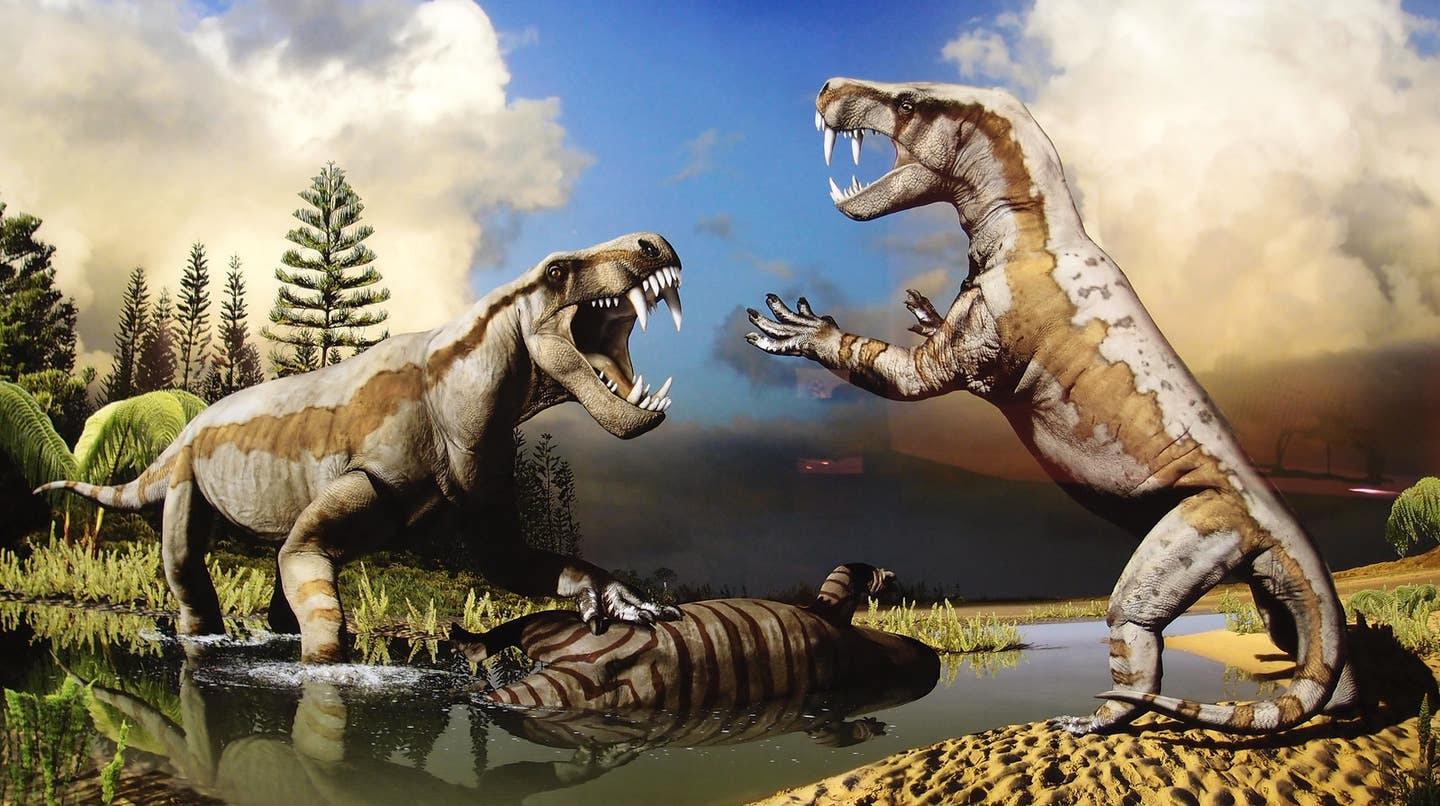Earth’s magnetic field failed 41,000 years ago – forever changing human evolution
During a brief but dramatic chapter in Earth’s history about 41,000 years ago, the planet’s magnetic field nearly collapsed.

A magnetic collapse 41,000 years ago let in solar radiation, changed the skies, and possibly shaped the fate of early humans. (CREDIT: DepositPhotos)
During a brief but dramatic chapter in Earth's history about 41,000 years ago, the planet’s magnetic field nearly collapsed. What followed was a cascade of environmental and biological changes that may have shaped the course of human evolution.
This period, called the Laschamps excursion, lasted around 2,000 years. The strength of Earth’s magnetic field dropped to just 10% of its current level, while the magnetic poles wandered far from their usual locations.
For about 300 years, the magnetic field tilted and weakened rapidly, behaving more like the multipolar magnetic fields of outer planets. This sudden shift allowed high-energy particles from the Sun to pierce the atmosphere more easily, threatening life on the ground and transforming the skies.
A Shield Under Stress
Earth’s magnetic field has long served as a vital shield against the harshness of space. Generated by the flow of molten iron in the outer core, this field forms the magnetosphere—a vast bubble that deflects charged particles from the Sun. This protective layer allows Earth to maintain an atmosphere, prevents ozone loss, and supports life.
As charged particles stream toward the planet in what’s known as the solar wind, the magnetosphere bends and stretches. On the dayside, it is compressed; on the nightside, it stretches into a long tail. These dynamic processes trap and accelerate particles, creating a space plasma environment extending tens to hundreds of Earth radii.
In the polar regions, the interaction between this plasma and the atmosphere gives rise to auroras—those flickering bands of green, red, and purple that light up the polar skies. The magnetic field also shields critical technology, including communication satellites and power grids, from the impacts of space weather.
But this shield is not constant. Over millions of years, it has wobbled, weakened, and even flipped direction entirely during events called geomagnetic reversals. Sometimes, instead of a full flip, the field experiences shorter, more rapid changes. These are known as geomagnetic excursions.
Related Stories
The Laschamps Excursion and a Planet in Flux
The most recent of these excursions—the Laschamps event—was first recorded in lava flows and sediment deposits. During this episode, the magnetic field lost much of its strength and coherence. Poles wandered unpredictably, the protective bubble around the planet weakened, and space plasma patterns changed drastically.
Recent research led by Agnit Mukhopadhyay at the University of Michigan offers new insights into what Earth looked like during this time. Using advanced computer models, Mukhopadhyay and his team recreated a three-dimensional view of Earth’s magnetic environment during the Laschamps excursion. This model connected three layers of the system: the geomagnetic field, the space plasma, and the auroral regions.
The team discovered that the weakened field allowed auroras to appear not just near the poles but over much of Europe and even parts of northern Africa. Magnetic field lines stretched outward, and more solar radiation reached the ground. This increase in radiation likely had major effects on Earth’s atmosphere, possibly altering its chemistry and circulation patterns.
More cosmic rays and ultraviolet light would have reached the surface, posing a threat to living organisms. This exposure might have driven humans and animals to adapt quickly—or disappear.
Human Responses in a Shifting World
Around the time of the Laschamps excursion, Homo sapiens and Neanderthals coexisted in Europe. But shortly after, Neanderthals vanished. Could changes in the magnetic field have played a role?
Mukhopadhyay, along with anthropologist Raven Garvey and a global team of researchers, began piecing together clues from archaeology, geology, and climate science. Their work, published in Science Advances, connects the weakening magnetic field with a spike in human behavioral changes.
One key adaptation may have been clothing. Archaeological evidence from Homo sapiens sites shows the use of needles, awls, and scrapers—tools likely used to make tailored garments. Unlike simple animal hides, fitted clothes offered more protection from both cold and solar radiation. Garvey points out that tailored clothing allowed people to travel farther from shelter and may have provided an unintended benefit: a barrier against damaging ultraviolet rays.
There’s also evidence that Homo sapiens began using ochre more frequently around this time. This naturally occurring pigment, rich in iron oxide, has long been used by human ancestors to decorate skin, tools, and cave walls. But experiments have shown that ochre also blocks ultraviolet radiation. It may have functioned as a prehistoric sunscreen.
“We found that many of those regions actually match pretty closely with early human activity from 41,000 years ago,” said Mukhopadhyay. “Specifically an increase in the use of caves and an increase in the use of prehistoric sunscreen.”
Neanderthals, by contrast, show little evidence of such adaptations. They lacked the tools for fitted clothing and may not have used ochre as sunscreen. Without these protective strategies, they might have been more vulnerable to solar radiation.
Where the Skies Lit Up
To model how the skies may have changed, Mukhopadhyay used the Space Weather Modeling Framework—an advanced system developed at the University of Michigan. This tool simulates the interaction between solar plasma and planetary magnetic fields.
Working with Sanja Panovska at Germany’s GFZ Helmholtz Centre for Geosciences, the team created a detailed map of the Earth’s space environment during the Laschamps event. This model showed where magnetic field lines opened up and where radiation could penetrate to the ground.
The auroras that we now associate with the Arctic and Antarctic likely stretched far into temperate regions. In fact, during the Laschamps excursion, much of Europe would have glowed with colorful, shifting lights. But this beauty came with danger. With the magnetic field so weak, radiation levels soared.
Garvey emphasized that solar radiation doesn’t just cause sunburns. It can lead to severe eye damage and reduce levels of folate, a vital vitamin needed for healthy pregnancies. “Having protection against solar radiation would also have conferred significant advantage to anyone who possessed it,” she said.
What the Past Tells Us About the Future
Mukhopadhyay’s model doesn’t just shed light on the past—it also offers a warning. If an event like the Laschamps excursion happened today, modern society could be in serious trouble.
“Our communication satellites would not work,” said Mukhopadhyay. “Many of our telecommunication arrays, which are on the ground, would be severely affected by the smallest of space weather events.”
The power grid could be at risk. Navigation systems would be unreliable. Radiation levels would rise, especially at high altitudes, affecting air travel. This research highlights the importance of understanding how magnetic field fluctuations could impact daily life.
There’s also a lesson for planetary science. Many astronomers believe a strong magnetic field is a requirement for life. But events like the Laschamps excursion show that life on Earth endured even when the field was weak. Studying these moments helps scientists rethink the conditions needed for life on other worlds.
As Mukhopadhyay puts it, “Looking at prehistoric Earth, and especially at events like this, helps us study exoplanetary physics from a very different vantage point. Life did exist back then. But it was a little bit different than it is today.”
Note: The article above provided above by The Brighter Side of News.
Like these kind of feel good stories? Get The Brighter Side of News' newsletter.
Joshua Shavit
Science & Technology Writer | AI and Robotics Reporter
Joshua Shavit is a Los Angeles-based science and technology writer with a passion for exploring the breakthroughs shaping the future. As a contributor to The Brighter Side of News, he focuses on positive and transformative advancements in AI, technology, physics, engineering, robotics and space science. Joshua is currently working towards a Bachelor of Science in Business Administration at the University of California, Berkeley. He combines his academic background with a talent for storytelling, making complex scientific discoveries engaging and accessible. His work highlights the innovators behind the ideas, bringing readers closer to the people driving progress.



